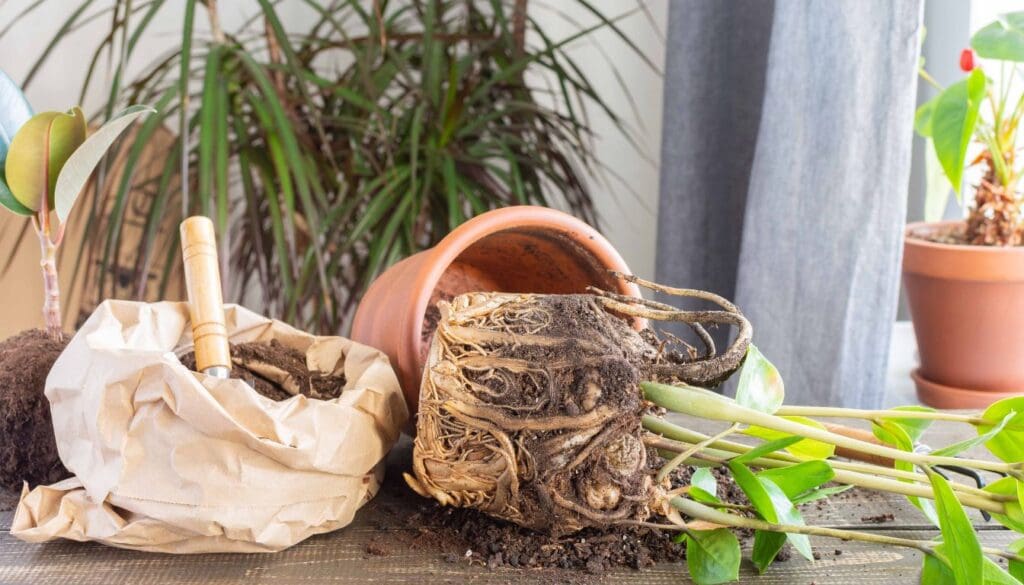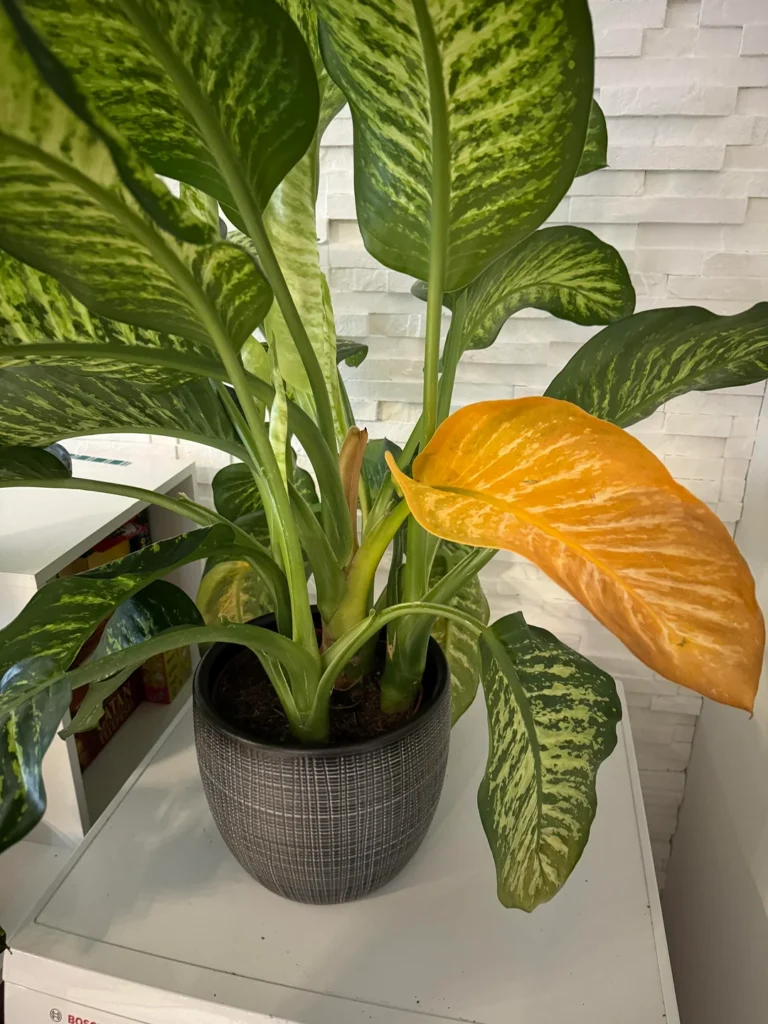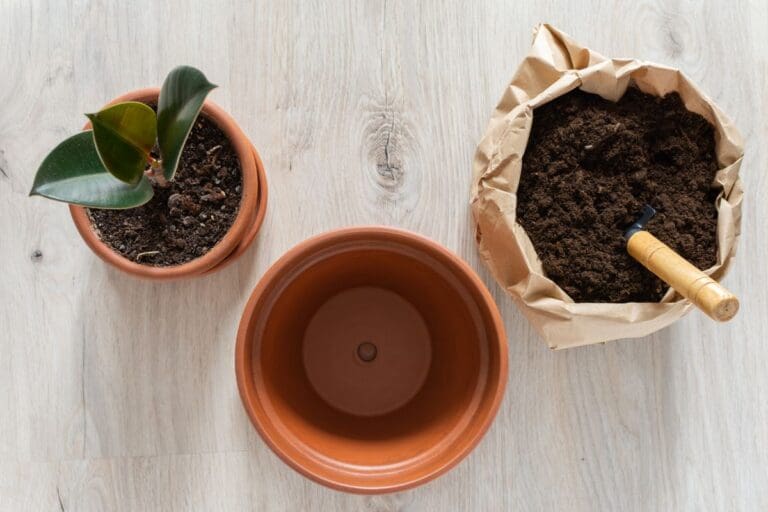7 Signs It’s Time to Repot Your Houseplant and How to Do It Right
I absolutely love watching my houseplants thrive, but, let’s be real, sometimes they just need a little more space. Repotting sounds intimidating at first, but it’s honestly a key part of keeping my plants happy.
Knowing when to repot keeps my plants strong and helps avoid all sorts of annoying growth problems. Plus, a few healthy plants just make my home feel brighter.

Please note: Simplify Plants is reader-supported. As an Amazon Associate, I earn from qualifying purchases made by our readers with no extra cost added to you all! Some links in the post are affiliate links and I get a commission from purchases made through links in the post.
1) Roots growing through drainage holes

Whenever I spot roots sneaking out of the drainage holes at the bottom of a pot, that’s a dead giveaway my plant wants more room. The roots are basically escaping because they’ve used up every inch of space inside.
If I lift up the pot and see long white or brown roots poking through, I know I can’t ignore it. Trapped roots get dry and unhappy, and that’s not what anyone wants.
When roots are all tangled at the bottom, my plant struggles to get water or nutrients. Sometimes, water just runs straight through—the soil can’t even hold onto it anymore.
Honestly, this is one of the easiest signs to catch. Every time I water, I peek at those drainage holes to see if any roots are saying hello.
Repotting helps prevent stress and keeps the plant chugging along. If I ignore those roots, the plant might slow down or start to look a bit sad.
So, when I see roots peeking out, I grab a slightly bigger pot. It’s a quick fix that really helps.
2) Soil dries out very quickly

Sometimes, I notice my plant’s soil dries out way faster than it used to. I used to water once a week, but suddenly it’s bone dry after just a day or two.
That usually means the roots have taken over the pot, leaving hardly any soil to hold water. The water disappears because there’s barely any soil left—just a mass of thirsty roots.
If I touch the soil and it’s dry right after watering, I’ll check underneath for roots poking out. That’s another hint it’s time to repot.
A plant that dries out this quickly just can’t get what it needs. I always pay attention to how the soil feels.
If I catch myself watering way more often, that’s a big clue it’s time for a bigger pot and fresh soil. My plants always perk up after that.
3) Plant looks top-heavy or crowded

Now and then, I’ll see my plant looking way too big for its pot. If leaves spill over or stems droop heavily, the pot’s probably too small.
A crowded plant just looks off-balance. If roots or stems are pushing up at weird angles, it’s a sign the plant’s totally outgrown its space.
When a plant is top-heavy, the roots can’t really support it anymore. Sometimes I have to prop it up so it doesn’t tip over.
If I gently slide the plant out and see roots circling around, it’s definitely root-bound. Crowded roots slow down growth.
My plant stops growing new leaves or looks less full because there’s just nowhere left to expand.
Top-heavy plants often dry out super fast, too. The soil can’t keep up with all those roots.
When I see this, it’s pretty obvious my plant needs a bigger home. Repotting gives it space to grow and keeps it standing tall.
4) Yellowing or dropping leaves

If I spot yellowing leaves or leaves dropping off, it always makes me pause. A few yellow leaves are normal, but if a bunch turn yellow at once, the roots might be in trouble.
Sometimes, leaves drop because the plant can’t get enough nutrients or water—crowded roots can’t do their job.
Limp, weak leaves are another red flag. Repotting can refresh the soil and give roots more breathing room.
I always check for roots poking out of the bottom if I see these leaf issues. That’s a big hint the plant’s cramped.
Leaf color says a lot. Healthy leaves should be a nice, rich green. If I see more yellow or brown, it’s time to step in.
Older leaves might drop naturally, but if new ones are falling too, something’s off. That’s when I start thinking about repotting.
Fresh soil and a bigger pot usually help new leaves come in strong. It’s a simple change with a big payoff.
5) Roots visible on soil surface

When I see roots poking up through the top of the soil, I know my plant’s probably outgrown its pot. Roots should be hidden underground, not exposed to air and sun.
If roots are pushing up, they’ve got nowhere else to go. Sometimes they even wrap around the inside of the pot.
I’ll poke around and check if the surface feels thick with tangled roots. That’s a sure sign the plant is root-bound and needs more space.
Leaving it cramped makes it harder for roots to soak up water and nutrients. The plant might start to look weak or just stop growing.
Whenever I spot roots on top of the soil, I know it’s time for a slightly bigger pot and some fresh soil. That’s how I keep my plant growing healthy and strong.
6) Slowed or stunted growth

It’s pretty obvious when my houseplant just stops growing. If months go by and I don’t see new leaves or stems, that’s a red flag. Plants should at least show some progress in the growing season.
Sometimes I water and feed my plant, but nothing seems to change. This slow or stunted growth usually means the roots are out of space. It’s honestly a little disappointing to wait for something new and see nothing.
I keep an eye out for any changes each month. If the size stays the same, it’s probably time to repot and give the plant more room.
Growth can stall if the soil is too compacted, too. Roots get tangled and can’t spread. A new pot with fresh soil almost always perks up my plant.
I’ve learned to recognize my plant’s normal growing speed. If it slows down for no reason, repotting might be the answer.
Sometimes, the old soil just doesn’t have enough nutrients left. Repotting gives the roots a fresh start.
When I notice these signs, a quick repot can make all the difference. I want my houseplants to stay happy, so I keep an eye out for stalled growth.
7) Water sits on soil surface for too long

I always notice how fast water drains when I water my plants. Sometimes, water just pools on top of the soil and takes forever to soak in.
That usually means the soil’s too compacted, or the roots have filled up every inch. Old or packed soil just can’t absorb water like it should.
If water stays on top for ages, the roots probably aren’t getting enough moisture. That stresses the plant and makes it tough for the roots to breathe.
I notice this more with older plants. Fresh, loose soil should let water pass through easily.
If water just sits there, it’s time to repot. Switching to a bigger pot with new soil helps a ton.
The roots get more space, and watering becomes way easier. My plants always seem happier after.
Understanding Why Houseplants Need Repotting
I try to keep an eye on root growth and the overall look of my houseplants. Fresh soil and a bit of extra space can do wonders for them.
Root Growth and Pot Limitations
Roots keep growing, even if there’s no space left. When a plant’s been in the same pot forever, the roots start circling around the edges. That’s called becoming root-bound.
A root-bound plant might have roots poking out of drainage holes or even pushing up above the soil. Sometimes the pot itself starts bulging or cracking. It’s wild how strong roots can be when they run out of room.
Here’s what happens in a small pot:
| Old Pot | Too Small | Roots Circle the Pot | Poor Drainage |
|---|---|---|---|
| Yes | Yes | Yes | Often |
When I see these things, I know my houseplant needs a bigger pot. Giving the roots room to stretch is just better for everyone.
Impact on Plant Health and Development
A crowded pot is bad news for a houseplant. Roots that can’t spread out don’t absorb water or nutrients well. That leads to slow growth, pale or yellow leaves, and fewer new shoots.
Sometimes, my plant just stops blooming or dries out right after watering. Overcrowded roots also make plants more likely to get sick or attract pests.
Repotting gives my plant fresh soil, which means new nutrients and better airflow. Fresh soil and a bigger pot help my plant bounce back and put out new growth.
Choosing the Right Pot and Soil

Whenever I repot, I try to pick the best pot and soil for the plant. The right choices help roots spread, prevent rot, and keep everything healthy.
Benefits of Upgrading Your Pot
A new pot gives my plant more room to grow. If roots are poking out or circling, a bigger pot lets them stretch out instead of getting cramped.
I always go for a pot with drainage holes. That way, extra water can escape and I don’t have to worry about root rot sneaking up on me.
The pot material matters, too. Clay pots dry out faster, which is great for plants that like things on the dry side. Plastic pots keep water in longer, so I use them for plants that need more moisture.
Check out the table below:
| Pot Material | Good For | Benefit |
|---|---|---|
| Clay | Dry-loving plants | Prevents soggy roots |
| Plastic | Moisture lovers | Holds water longer |
Soil Selection Tips
Using the right soil keeps my plant healthy and lets the roots breathe. I never use dirt from outside—too many chances for pests or weird weed seeds to sneak in.
For most houseplants, I pick up a potting mix made specifically for indoor plants. It’s light, drains well, and has the nutrients my plants seem to love.
If I’m dealing with a cactus or succulent, I’ll grab a special mix that’s got sand or perlite blended in. That way, water doesn’t just sit there.
I always check the label on the bag—it’s worth the extra second to make sure it fits my plant’s needs. Heavy or sticky soils? I steer clear; they just hold too much water, and nobody wants root rot.
Frequently Asked Questions
I try to keep an eye out for roots poking through the pot or soil drying out way too fast. Timing the pot change and picking the right soil really does make a difference.
What are the indicators that my houseplant needs a new pot?
I notice roots coming out of the drainage holes or sometimes even popping up on the surface. If the plant looks crowded or top-heavy, or if the soil dries out super quick, it’s probably time.
Leaves turning yellow or just dropping off can be a sign too. It’s not always obvious, but these little things add up.
How often should I plan to repot my fiddle leaf fig for optimal growth?
I usually end up repotting my fiddle leaf fig every year or two. If it seems like growth is slowing or roots are circling the bottom, I’ll do it sooner.
Spring is my go-to season for this—it just seems to give the plant a boost.
What type of soil is best when repotting a pothos plant?
For my pothos, I stick with a well-draining potting mix. Heavy garden soil just doesn’t work.
A mix with peat moss, a bit of perlite, and some pine bark keeps the roots happy and not too soggy.
Can you give tips on repotting a large houseplant without damaging it?
When I need to move a big plant, I water it the day before and gently loosen the root ball by tilting the pot. Supporting the plant at the base helps a lot.
Honestly, asking a friend for help makes the whole thing way less stressful—for both me and the plant.
How can I tell if my plant is root bound and requires repotting?
I check if the roots are circling the pot or getting all tangled at the bottom. Roots poking out of the drainage holes or showing up above the soil are pretty clear signs.
If growth is sluggish and water runs straight through, it’s probably root bound.
What is the best time of the year to repot indoor plants?
Honestly, I prefer to repot in the spring. That’s when most houseplants wake up and start growing again, so they bounce back faster from the whole ordeal.
Winter? I’d skip it. Plants just want to rest then, and repotting would probably annoy them (if plants could be annoyed).
Recommended Garden Supplies
| Product Image | Our Recommended Gardening Supplies | Check Offers! |
|---|---|---|
Top Top
Top
Top
Top
Top
Top
Top
Top | rePotme Houseplant and Tropical Classic Potting Soil Mix | Check Offer On Amazon |
 Top
Top
Top
Top
Top
Top
Top
Top | Espoma Organic Indoor Plant Food | Check Offer On Amazon |
 Top
Top
Top
Top
Top
Top
Top
Top | GooingTop LED Grow Light 6000K Full Spectrum Clip Plant Growing Lamp | Check Offer On Amazon |
 Top
Top
Top
Top
Top
Top
Top
Top | Soil Moisture Meter | Check Offer On Amazon |
 Top
Top
Top
Top
Top
Top
Top
Top | Govee Hygrometer Thermometer, Bluetooth Enabled! | Check Offer On Amazon |
 Top
Top | LEVOIT Humidifiers for Large Room(Best For Plants) | Check Offer On Amazon |
 Top
Top
Top
Top
Top
Top
Top
Top | Upgraded DIY Automatic Drip Irrigation Kit, 15 Potted Houseplants Support | Check Offer On Amazon |
 Top
Top
Top
Top
Top
Top
Top
Top | Stainless Steel Heavy Duty Gardening Tool Set | Check Offer On Amazon |
 Top
Top
Top
Top
Top
Top
Top
Top | Bonide Insecticidal Soap | Check Offer On Amazon |
 Top
Top
Top
Top
Top
Top
Top
Top | Bonide 32 oz Spray Neem Oil for Organic Gardening | Check Offer On Amazon |
 Top
Top
Top
Top
Top
Top
Top
Top | Garden Safe Fungicide | Check Offer On Amazon |






